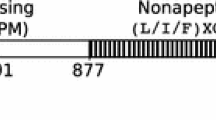Abstract
Bacillus subtilis ATCC 6633 produces the lipid II targeting lantibiotic subtilin. For self-protection these gram-positive bacteria express a cluster of four self-immunity proteins named SpaIFEG. SpaI is a 16.8 kDa lipoprotein which is attached to the outside of the cytoplasmic membrane via a covalently linked diacylglycerol anchor. Together with the ABC-transporter SpaFEG, SpaI protects the membrane from subtilin insertion and there is evidence for a direct interaction of SpaI with subtilin. As a prerequisite for further structural studies of SpaI and the SpaI/subtilin complex we report here the full 1H, 15N, 13C chemical shift assignment for a stable 14.9 kDa C-terminal fragment of SpaI.

Similar content being viewed by others
References
Bierbaum G, Sahl HG (2009) Lantibiotics: mode of action, biosynthesis and bioengineering. Curr Pharm Biotechnol 10:2–18
Breukink E, Wiedemann I, van Kraaij C, Kuipers OP, Sahl H, de Kruijff B (1999) Use of the cell wall precursor lipid II by a pore-forming peptide antibiotic. Science 286:2361–2364
Brötz H, Josten M, Wiedemann I, Schneider U, Götz F, Bierbaum G, Sahl HG (1998) Role of lipid-bound peptidoglycan precursors in the formation of pores by nisin, epidermin and other lantibiotics. Mol Microbiol 30:317–327
Eghbalnia HR, Wang L, Bahrami A, Assadi A, Markley JL (2005) Protein energetic conformational analysis from NMR chemical shifts (PECAN) and its use in determining secondary structural elements. J Biomol NMR 32:71–81
Engelke G, Gutowski-Eckel Z, Kiesau P, Siegers K, Hammelmann M, Entian KD (1994) Regulation of nisin biosynthesis and immunity in Lactococcus lactis 6F3. Appl Environ Microbiol 60:814–825
Gross E (1975) Subtilin and nisin: the chemistry and biology of peptides with alpha, beta-unsaturated amino acids, p. 31–42. In: R.Walter and J. Meienhofer (ed.), Peptides: chemistry, structure and biology: proceedings of the fourth American Peptide Symposium. Ann Arbor Sciecne, Ann Arbor, MI., pp. 31–42
Halami PM, Stein T, Chandrashekar A, Entian K-D (2010) Maturation, processing of SpaI, the lipoprotein involved in subtilin immunity in Bacillus subtilis ATCC6633. Microbiol Res 165:183–189
Keller R (2004) The computer aided resonance tutorial. CANTINA Verlag, Goldau
Klein C, Entian KD (1994) Genes involved in self-protection against the lantibiotic subtilin produced by Bacillus subtilis ATCC 6633. Appl Environ Microbiol 60:2793–2801
Markley JL, Bax A, Arata Y, Hilbers CW, Kaptein R, Sykes BD, Wright PE, Wuthrich K (1998) Recommendations for the presentation of NMR structures of proteins and nucleic acids. IUPAC-IUBMB-IUPAB inter-union task group on the standardization of data bases of protein and nucleic acid structures determined by NMR spectroscopy. J Biomol NMR 12:1–23
Muchmore DC, McIntosh LP, Russell CB, Anderson de, Dahlquist FW (1989) Expression and nitrogen-15 labeling of proteins for proton and nitrogen-15 nuclear magnetic resonance. Methods Enzymol 177:44–73
Parisot J, Carey S, Breukink E, Chan WC, Narbad A, Bonev B (2008) Molecular mechanism of target recognition by Subtilin, a Class I Lanthionine Antibiotic. Antimicrob Agents Chemother 52:612–618
Salzmann M, Pervushin K, Wider G, Senn H, Wüthrich K (1998) TROSY in triple-resonance experiments: new perspectives for sequential NMR assignment of large proteins. Proc Natl Acad Sci USA 95:13585–13590
Sattler M, Schleucher J, Griesinger C (1999) Heteronuclear multidimensional NMR experiments for the structure determination of proteins in solution employing pulsed field gradients. Prog Nucl Magn Reson Spectrosc 34:93–158
Schnell N, Entian KD, Schneider U, Götz F, Zähner H, Kellner R, Jung G (1988) Prepeptide sequence of epidermin, a ribosomally synthesized antibiotic with four sulphide-rings. Nature 333:276–278
Schüller F, Benz R, Sahl HG (1989) The peptide antibiotic subtilin acts by formation of voltage-dependent multi-state pores in bacterial and artificial membranes. Eur J Biochem 182:181–186
Shen Y, Bax A (2010) Prediction of Xaa-Pro peptide bond conformation from sequence and chemical shifts. J Biomol NMR 46:199–204
Shen Y, Delaglio F, Cornilescu G, Bax A (2009) TALOS+: a hybrid method for predicting protein backbone torsion angles from NMR chemical shifts. J Biomol NMR 44:213–223
Stein T, Heinzmann S, Düsterhus S, Borchert S, Entian K-D (2005) Expression and functional analysis of the subtilin immunity genes spaIFEG in the subtilin-sensitive host Bacillus subtilis MO1099. J Bacteriol 187:822–828
Tugarinov V, Kanelis V, Kay LE (2006) Isotope labeling strategies for the study of high-molecular-weight proteins by solution NMR spectroscopy. Nat Protoc 1:749–754
Vranken WF, Boucher W, Stevens TJ, Fogh RH, Pajon A, Llinas M, Ulrich EL, Markley JL, Ionides J, Laue ED (2005) The CCPN data model for NMR spectroscopy: development of a software pipeline. Proteins 59:687–696
Willey JM, van der Donk WA (2007) Lantibiotics: peptides of diverse structure and function. Annu Rev Microbiol 61:477–501
Acknowledgments
We are grateful to Dr. Christian Richter for help with the NMR experiments and to Sophie Bochmann for helpful discussions. We thank Prof. Volker Dötsch for the kind gift of the TEV-protease construct and Björn Meyer and Prof. Michael Karas for the MALDI-MS analysis of the C-terminal SpaI fragment. The eNMR project (European FP7 e-Infrastructure grant, contract no. 213010, www.enmr.eu), supported by the national GRID Initiatives of Italy, Germany and the Dutch BiG Grid project (Netherlands Organization for Scientific Research) is acknowledged for the use of web portals, computing and storage facilities. This project was supported by an Aventis Foundation professorship (to J.W.), the Center of Biomolecular Magnetic Resonance (BMRZ), the Cluster of Excellence “Macromolecular Complexes” and the Förderfonds of the Goethe University Frankfurt am Main.
Author information
Authors and Affiliations
Corresponding author
Rights and permissions
About this article
Cite this article
Christ, N.A., Duchardt-Ferner, E., Düsterhus, S. et al. NMR resonance assignment of the autoimmunity protein SpaI from Bacillus subtilis ATCC 6633. Biomol NMR Assign 6, 9–13 (2012). https://doi.org/10.1007/s12104-011-9314-5
Received:
Accepted:
Published:
Issue Date:
DOI: https://doi.org/10.1007/s12104-011-9314-5




